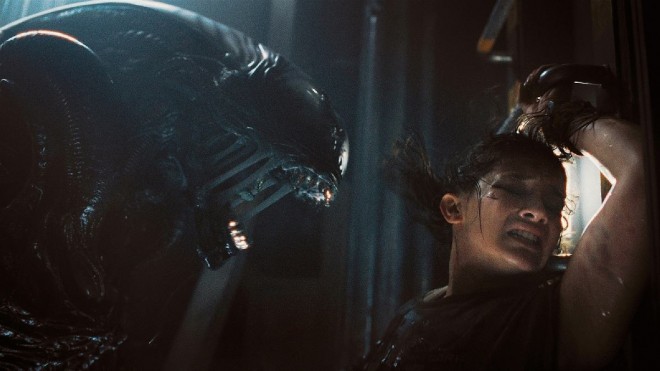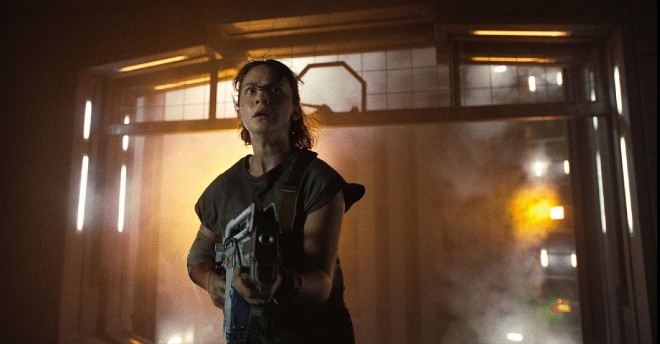INTERVIEW: 'Alien' is the Dark Side of 'Star Wars' - Director Fede Álvarez on Alien: Romulus
On September 6th, Alien: Romulus began screening in theaters across Japan. This latest installment is the seventh in the iconic sci-fi horror series that started with Ridley Scott’s Alien in 1979. What is it about the Alien series, now running for 45 years, that continues to captivate audiences? We asked director Fede Álvarez in an online interview.

Alien: Romulus © 2024 20th Century Studios. All Rights Reserved.
The original Alien depicted the terrifying horror of crew members on a spaceship being attacked one by one by an alien. This parasitic creature, bursting out of human chests and evolving at a terrifying speed, has become one of the most unique monsters in film history. Its unsettling design and the intense battle for survival within the confined space of the spaceship, led by Sigourney Weaver’s character, became legendary, winning multiple awards, including the Academy Award for Best Visual Effects at the 52nd Academy Awards. The word "alien" has since become synonymous with extraterrestrial beings.
Since then, although each Alien film has a different tone, the series has consistently captured the hearts of audiences worldwide with its distinctive universe. The latest entry, Alien: Romulus, has already debuted at number one in several countries, including the United States, China, the UK, Spain, and South Korea, proving the series' enduring appeal.

Alien: Romulus © 2024 20th Century Studios. All Rights Reserved.
To me, Alien feels like the dark side twin of Star Wars
Director Álvarez commented, “It’s really the vastness of this universe. There are so many stories to tell within it. I think it resonates with audiences much like Star Wars. I believe Alien works in a similar way. It’s not just the characters; everyone is drawn to the world of Alien and wishes to return to it.”
He continued, “To me, Alien feels like the dark side twin of Star Wars (laughs). The first Alien came out just over a year after Star Wars: A New Hope (1977), and it felt like a kind of response film with a very similar aesthetic. But it had a darker, scarier tone, more suited for adults, and introduced horror and thrill that Star Wars didn’t have. As long as Star Wars stays strong, I believe Alien will too,” explaining how the similarities and differences between these two big titles enhance their appeal.

Alien: Romulus © 2024 20th Century Studios. All Rights Reserved.
Hidden a lot of Easter eggs
When asked about the similarities with Blade Runner (1982, also directed by Ridley Scott), Álvarez acknowledged them, saying, "You can’t avoid it. Both are part of Ridley Scott’s universe, and for many fans, including myself, the boundary between the Alien universe and the Blade Runner universe is quite blurred. Even though I didn’t intentionally insert homages as the director, I know the art and set directors, who are big Blade Runner fans, have hidden a lot of Easter eggs (laughs).”
Álvarez revealed one Easter egg he spotted: “There’s the origami from Blade Runner. You can see it in the cockpit of this film, so keep an eye out for that. There are many others too.”
He also spoke about the connection with the original Alien. “If you know the original, you’ll have a moment of ‘Oh, that’s where they went with this!’ But even if you haven’t seen it, you’ll still enjoy the film. As a fan myself, there are things I wanted to see on screen, like connections with the past films—it’s just thrilling.”
However, he added, “It would be unfair if the film hindered the understanding of new audiences who haven’t seen the past series. I didn’t want younger generations who haven’t watched the original to be turned off. I want to provide new audiences with a cinematic experience similar to what previous viewers experienced with the earlier films.”
About The Movie
The latest film, Alien: Romulus, is set in a space station called Romulus, where six young people, who have lost direction in life, enter in search of hope. With no specialized knowledge and not being soldiers, these ordinary young people face the universe’s most powerful and terrifying creature—the Alien—and experience the despair of having a "0% survival rate."
Source : ORICON NEWS
![[Movie] 'Minecraft: The Movie' Set for 2025 Release – Starring Jason Momoa and Jack Black](/upimg/thumb/1000/1663/img280/866eda149c1ec11fe779ebd87ab60ef7.jpg)
![[Movie] GHOST IN THE SHELL: Atsuko Tanaka's Iconic Role Re-Released in 4K in Shibuya](/upimg/thumb/1000/1644/img280/06cb95b14f2a21f80de2e91dcbe90fdd.jpg)
![[Gundam] Mobile Suit Gundam THE ORIGIN: Re-Edited Movie Edition Set for Theatrical Release in Three Chapters](/upimg/thumb/1000/1639/img280/10cc6ad278bd6530a24ba42cc79e74cc.jpg)

![[Interview] Manga on Nankai Megathrust Earthquakes Sees 18x Sales Surge: Editor Reflects on the Impact](/upimg/thumb/1000/1638/img280/85326902ad3b39c3fe706b45821f56c1.jpg)

![[Interview] Manga Artist Undertakes the Monumental Task of Adapting the "Greatest SF Novel of the 20th Century" into Manga: "I Want to Illustrate the Images in the Author's Mind"](/upimg/thumb/1000/1439/img280/e60ee917b65d98746b955620ce62c32e.jpg)
![[INTERVIEW] "Inside Out 2" Becomes a Global Hit with Relatable Adult Emotions: Interview with the Director & Producer](/upimg/thumb/1000/1345/img280/195dac8340d3cba187878afff7a9a94c.jpg)
![[INTERVIEW] Pete Docter of Pixar Discusses Anxiety Over Ennui and the Joy of Global Success](/upimg/thumb/1000/1344/img280/e9b03b950f67b3052f33628b7be6e33d.jpg)